AppleInsider · Kasper's Automated Slave
About
- Username
- AppleInsider
- Joined
- Visits
- 52
- Last Active
- Roles
- administrator
- Points
- 10,708
- Badges
- 1
- Posts
- 66,634
Reactions
-
Merry Christmas, from the entire AppleInsider team
All of us at AppleInsider wish you a happy and peaceful holiday season, and thank you for reading us throughout a roller-coaster 2024.

Jony Ive helped design the decorations for this tree, displayed in London's Claridge's store in 2018
Every year for the last 25 has been a big one for Apple, and you'd expect it for a company of its size. It launched the Apple Vision Pro, it joined the AI arms race with Apple Intelligence, and even found some time to release new products like the iPhone 16.
With the end of the year fast approaching, the Apple News cycle is temporarily winding down, but AppleInsider won't be taking a break. Throughout the holidays, we will be with you, sharing the latest news stories and using our expertise to discuss how the news of the day impacts our favorite company, as it happens.
It's also a time when the editorial team does a lot of preparation work for CES 2025, which kicks off the year. As usual, AppleInsider will be on the show floor, checking out new products that their creators claim will be the future of the industry.
Of course, this time of year is dominated by a more immediate event for many people, as they have to come to grips with Apple products given as presents. Millions of people will have a new iPhone, an Apple Watch, or maybe some AirPods as a gift from others, or even to themselves.
Whether you're in need of assistance setting up your new hardware -- or the likely scenario that you have to be family tech support once again -- we have guides covering how to set up new devices, which we continually keep up to date.
As the year prepares to tick over to 2025, AppleInsider looks to the future, as always. It's been 27 years since our founding, and AppleInsider has repeatedly evolved to serve its readership as the tech news landscape changes.
Taking into account all members of our editorial team, we have well over a century of experience with Apple hardware to draw on. From the newest releases to some of the oldest items from the company's history, we've got it all covered.
It's one thing to have all of this expertise, but getting it out into the world to the people who need it most has been a shifting problem. Google's algorithmic changes, social media's unsteady relationship with the media, and journalistic shifts force us, and pretty much everyone else in the tech news space, to change battle plans all the time.
We are already making changes to meet these new challenges, but you can always have your say on what we do. Over the next two weeks, we'll be discussing how we work, and what we work with, so you can see behind the scenes of our offices, spread across the globe.
And, you can join the discussions on the AppleInsider forums to have your say on the year, check out the opinions of your fellow readers, and to make new friends while most of the tech world takes a breath.
As always, we will see you in the comments, the forums, social media, YouTube, and our Discord, now and in 2025.
Read on AppleInsider



-
TikTok videos claim anyone can steal your credit cards with AirDrop
Before you start panicking: no, people can't steal your credit cards via AirDrop.
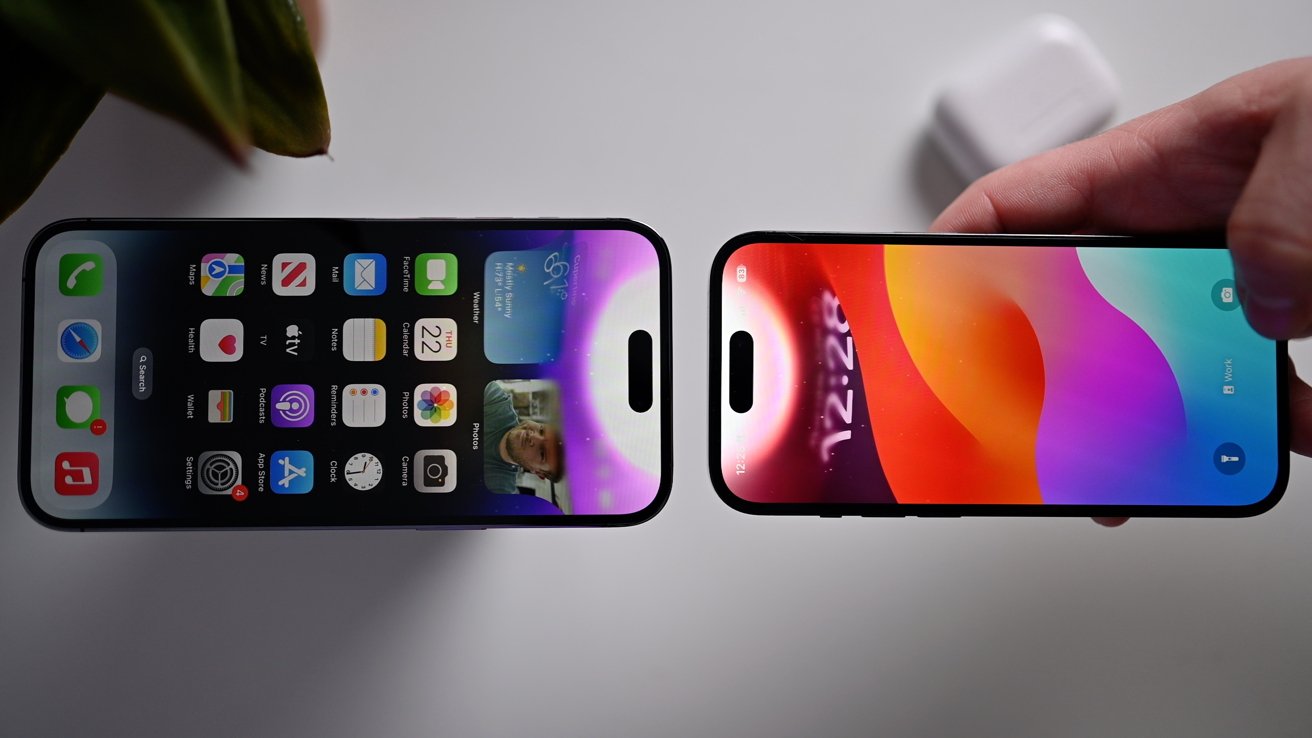
Contact sharing via the iPhone
Yet another TikTok conspiracy video surrounding the iPhone has taken off. This time, the rumor warns users that AirDrop could be used to give anyone unrestricted access to "everything" stored within your iPhone -- including anything stored within Apple Wallet.
It's unclear what the source of the rumor is, but creators like @vanessaromito13 are directing users to head to settings to disable AirDrop sharing.
In the video, @vanessaromito13 gives users instructions to disable "search with other iPhones," which isn't a feature that exists. Presumably, she's actually directing users to turn off either "Bringing Devices Together" or AirDrop's ability to receive an AirDrop from anyone, a feature which must be enabled and turns off after 10 minutes.
Another video, spotted by Daily Dot, @the_journey76 claims that malicious actors can "walk past you now and from one iPhone to another using that AirDrop setting, they can get all of the cards in your wallet. In your Apple Wallet." He directs users to disable AirDrop entirely as a precaution.
Both videos point the blame at a "recent update," which at the time would have been iOS 18.1, which came out in October. And, as expected, the comment sections of these videos are filled with both Apple detractors and defenders.
But before you go throwing your iPhone into the nearest garbage can, just remember: outrage and panic are common content engagement tactics. These sorts of rumors quickly spread on social media, often morphing and changing into entirely new ones.
The fact of the matter is that AirDrop cannot be used to transfer your credit or debit card information to another user. Not only would that be a huge liability for Apple, but it wouldn't be a particularly useful feature in the first place.
There aren't a lot of times when a user would actually need to give their card information directly to another iPhone user. If you're paying someone, you're likely going to use an app like Zelle, Venmo, PayPal, or even Apple's built-in pay features, such as Apple Pay features through iMessage or Tap to Pay on iPhone.
So, if this isn't a big deal, you're probably wondering where these content creators got the idea in the first place. That's likely a bit harder to suss out, but it's perhaps a cobbling together of many different concerns.
In iOS 17, Apple enabled users to share contact information easily through a new feature called NameDrop. NameDrop allows users to easily share pertinent contact information along with their Contact Poster with an NFC tap.
The feature is useful for sharing your information with someone without needing to type it all out. However, there were also concerns that the feature could be used for harassment, but there are safeguards in place to prevent that from happening.
More recently, a new feature in iOS 18.1 allows users to grant remote access to their Apple devices via FaceTime. As Daily Dot points out, this feature requires explicit permission, and access can be revoked at any time.
And, even if someone opened your Wallet app while remotely accessing your device, the app itself doesn't provide much useful information. Card numbers are hidden, with only the last four digits available to view.
That being said, it is still possible to get scammed via Apple Pay, though. In May, AppleInsider learned of an Apple Pay scam where scammers erroneously charge users extra money through the iPhone's tap-to-pay feature.
Instead of AirDrop, these scams rely on a scammer targeting particularly stressed individuals and hoping they don't notice the extra charge before it's too late.
Similar scams also exploit the near-field communication (NFC) chip transitions, like Apple Pay's tap-to-pay feature. In these scenarios, a potential scammer could swoop in and "steal" a transaction by holding their phone near a busy pay point, like those at a music festival or convention.
This is why it pays to be vigilant. Don't leave your Apple Pay screen up until you're ready to pay. It's also critical that you see the transition amount before you tap your device on a pay point.
If you get scammed, reach out to the bank in question. While Apple may make your iPhone, they don't have any control over how you use it. Your bank or credit card issuer, on the other hand, does have a say in where your money goes.
Read on AppleInsider
-
Government says DOJ subpoenaed Apple without authorization
DOJ demands for message and call data from Apple during the Trump administration, failed to obtain authorization, says the Office of the Inspector General in the current Biden administration.

United States Department of Justice -- image credit: DOJ
It was previously revealed in 2021 that the Department of Justice under President Trump subpoenaed Apple for data concerning at least two House Democrats, their aides and families, in an investigation into alleged leaking of information. Now a report from the Office of the Inspector General (OIG) says the DOJ's demands were issued without the required legal authorization.
The full OIG report also says that the DOJ did not have authorization for the gag orders that it imposed on both Apple and Google. It also reveals that the scope of the demands was wider than previously known, with the DOJ issuing 40 non-disclosure orders (NDOs) to the two companies.
NDOs, or gag orders, require authorization from the Attorney General before being imposed, and the DOJ failed to get this.
The Department also didn't "convene the News Media Review Committee to consider the authorization requests in the three investigations," says the OIG. For at least one of the three investigations, the OIG says the Department "did not obtain the required DNI [Director of National Intelligence] certification."
Reportedly, the DOJ also renewed most of its NDOs at least once. The renewals included one issued by the DOJ after the department had already concluded that the specified individual did not leak information.
"Given the important interests at stake, we were troubled that these failures occurred," says the OIG, "particularly given that only a few years had elapsed since the Department substantially overhauled its News Media Policy in 2014 and 2015 following serious criticisms concerning the Department's efforts to obtain communications records of members of the news media."
"Having once again revised its News Media Policy to address this most recent criticism," continues the report, "the Department must make every effort to ensure full and exacting compliance with its new policy in the future."
As originally reported in 2021, the OIG report says that the DOJ "did not receive any call detail records from Apple in response to this compulsory process." It did, however, get information such as whether there were Apple accounts for specified phone numbers.
Separately, the DOJ has filed an antitrust suit against Apple, accusing it of monopolistic practices. Apple has been attempting to get the courts to dismiss the suit.
Read on AppleInsider
-
Hands on with Kuxiu X36W Pro Max Magnetic iPad Wall Mount Charging Stand
Kuxiu has a range of magnetic charging stands for iPad, and the wall-mounted version has finally arrived. Here are my impressions of this variation of the stand.
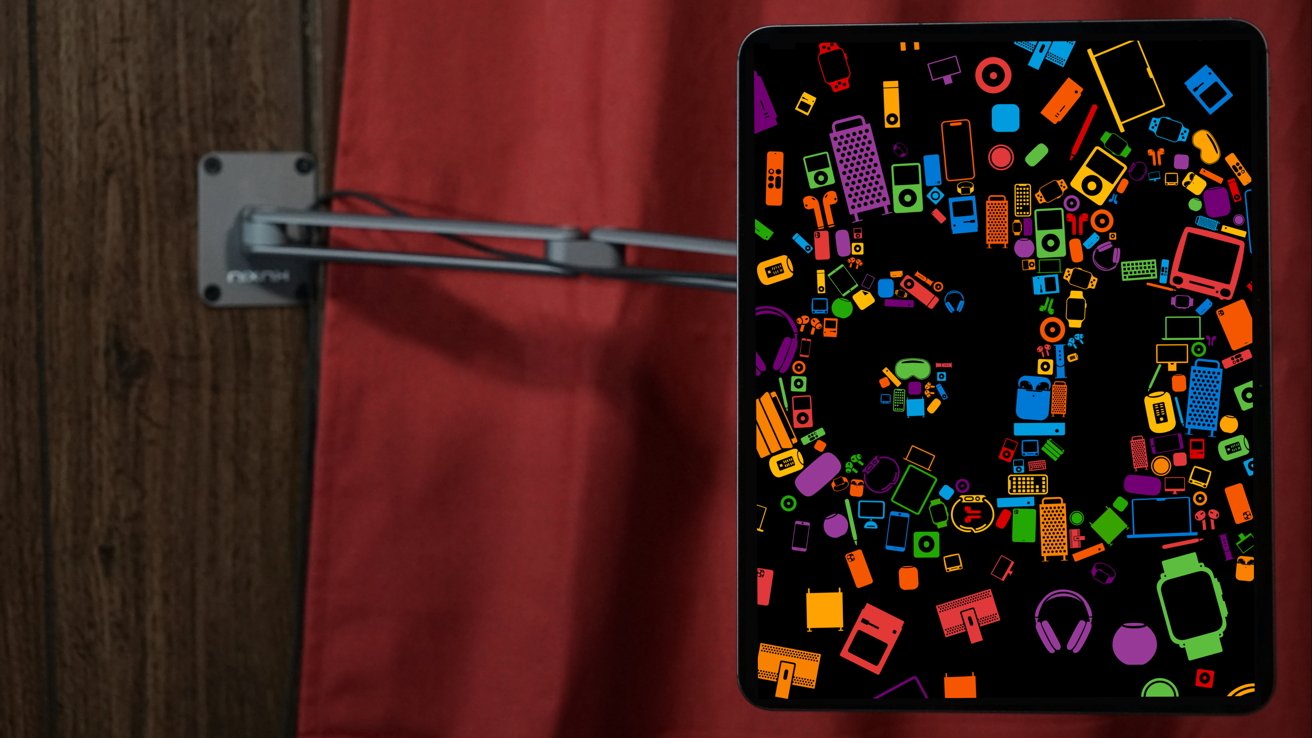
Wall mount your iPad and keep it charged via the Smart Connector
When Kuxiu started adding Smart Connector pins to its lineup of charging stands, I knew it would be a game changer. Previously, the iPad would need to be attached, then a cable plugged in for power, but now that's no longer necessary.
I already covered the lineup of traditional stands and clamp mounts from Kuxiu and Lululook with the new wireless charging option, but one was missing. The screw-in wall mount on a swivel arm hadn't made the move to wireless charging until just recently.
I've enjoyed Kuxiu's folding stands before, but only the desk-mounted ones. I had an idea for a wall-mounted stand, but didn't want to deal with the power problem.
The X36W Pro Max solves the power problem with the Smart Connector addition, and now I've got the perfect stand for my use case. Note that in order to provide power through the Smart Connector, the stand is emulating a keyboard, so the digital keyboard won't show up without being told to while using these powered stands.Magnetic wall-mounted iPad charging
I use my iPad in bed, normally the iPad mini, but I've taken to liking the lightweight and size of the 13-inch iPad Pro. However, lying down with such a large display isn't practical.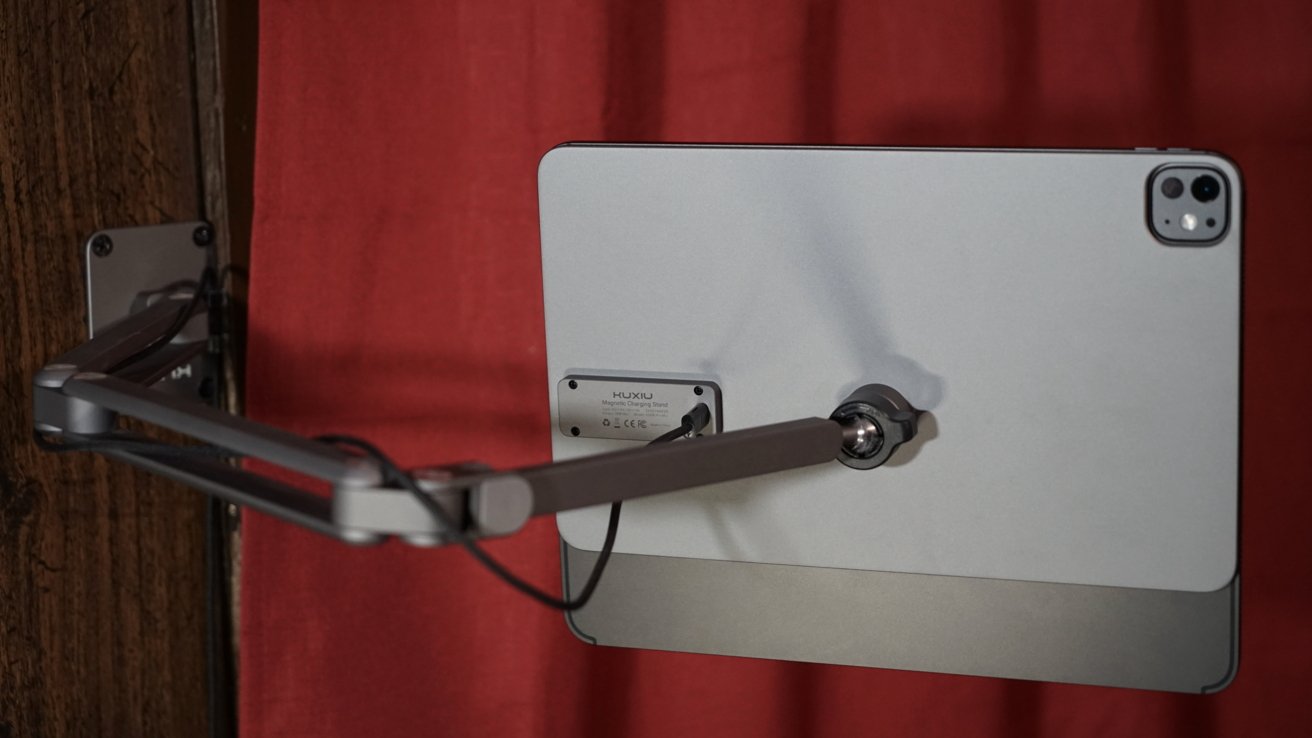
Snake the charging cable through to the charging stand and forget about it
So, I mounted Kuxiu's X36W Pro Max stand above my bed. Yes, I installed it upside down, but I didn't bother correcting it as it's directionally agnostic besides the logo placement. Ignore the terrible old panel walls.
I wasn't sure what to think of the new stand and its placement, but it worked out excellently. The arm folds up to tuck the tablet mount into the wall unobtrusively. It does stick out from the wall a bit, but not enough to be an issue while I'm lying in bed.
For those of you asking, no, it's not an issue with my partner nor does it create problems crowding the space. I enjoy using the mount when catching up on social media timelines, watching videos, or reading a book.
Mounting the tablet this way above the bed is the ideal gaming setup. I can grab a nearby controller and play games on the iPad or stream from my PS5 remotely, all comfortably from my bed without needing to worry about iPad placement or charging cables.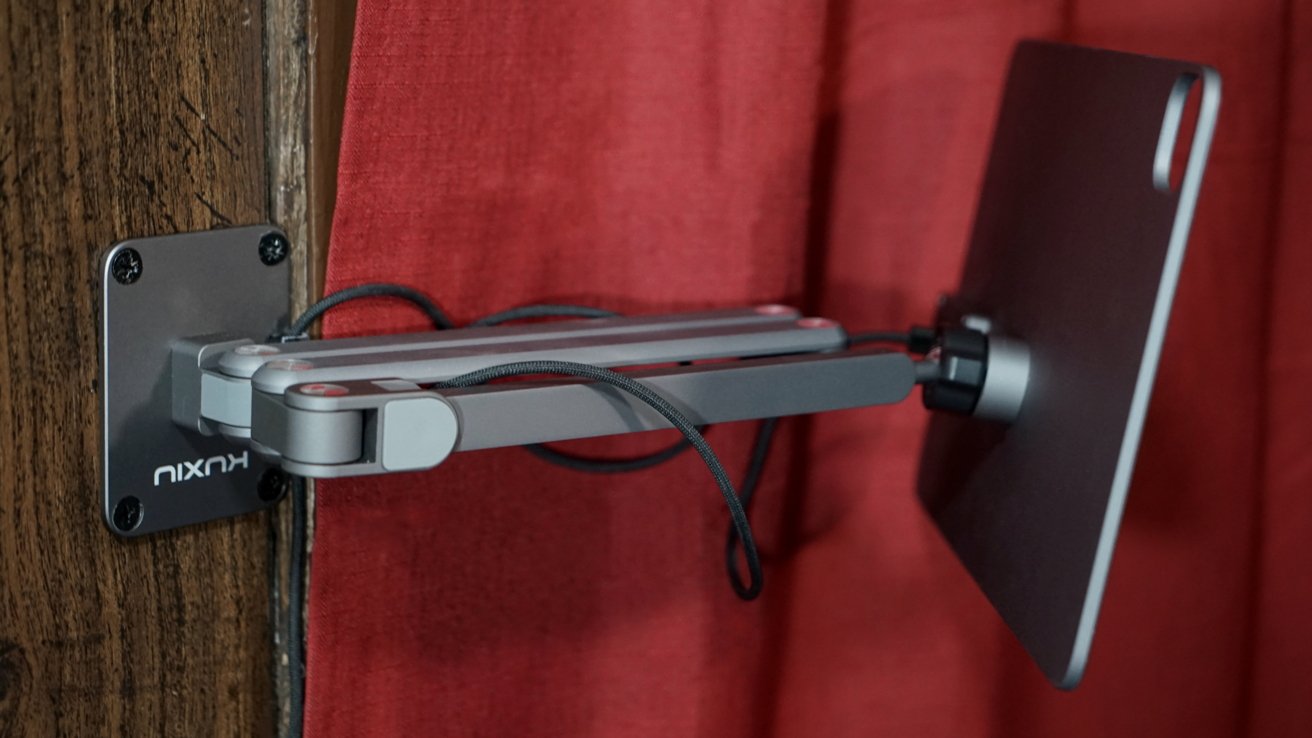
Fold up the stand when not in use
Of course, that's just my use case. This kind of mount would be great in the kitchen, above a desk, or in a workshop. The arm is wide-reaching and easy to maneuver.
Unlike the desk stand, the arm is very loose-feeling and the joints are easy to manipulate. You only need two hands when rotating the iPad or moving the arm more than 180 degrees at any joint.
The charge through the Smart Connector is slow, but enough to keep the iPad battery from draining while in use. It makes moving the iPad from room to room and keeping it charged an effortless process.
Choose the correct model for your iPad -- it is a one-to-one match for each model. There are versions for the 13-inch iPad Pro/Air, 11-inch iPad Pro/Air, 12.9-inch iPad Pro third-generation and newer, and 10.9-inch iPad Air fourth and fifth-generation.
Get the Kuxiu X36W Pro Max Magnetic iPad Wall Mount Charging Stand from the Kuxiu website for a discounted $104.49. It is normally $139.99. Coupon code APPLEINSIDER takes an additional 10% off, bringing the cost down to $94.04 at the time of publication.
Read on AppleInsider
-
M4 Mac minis in a computing cluster is incredibly cool, but not hugely effective
There is a way to use a collection of M4 Mac minis in a cluster, but the benefits only really exist when you use high-end Macs.

A cluster of M4 Mac minis - Image credit: Alex Ziskind/YouTube
While most people think of having a more powerful computer means buying a single expensive device, there are other ways to perform large amounts of number crunching. In one concept that has been around for decades, you could use multiple computers to handle processing on a project.
The concept of cluster computing revolves around a task with lots of calculations being shared between two or more processing units. Working together to complete tasks in parallel, the result is a severe shortening of time to process.
In a video published to YouTube on Sunday, Alex Ziskind demonstrates a cluster computing setup using the M4 Mac mini. Using a collection of five Mac minis stacked in a plastic frame, he sets a task that is then distributed between them for processing.
While typical home cluster computing setups rely on Ethernet networking for communications between the nodes, Ziskind is instead taking advantage of the speed of Thunderbolt by using Thunderbolt Bridge. This speeds up the communications between the nodes considerably, as well as allowing larger packets of data to be sent, saving on processing performance.
Ethernet can run at 1Gb/s normally, or up to 10Gb/s if you paid for the Ethernet upgrade in some Mac models. The Thunderbolt Bridge method can instead run at 40Gb/s for Thunderbolt 4 ports, or 80Gb/s on Thunderbolt 5 in M4 Pro and M4 Max models when run bi-directionally.Better than GPU processing
Ziskind points out that there can be benefits to using Apple Silicon rather than a PC using a powerful graphics card for cluster computing.
For a start, processing using a GPU relies on having considerable amounts of video memory available. On a graphics card, this could be 8GB on the card itself, for example.
Apple's use of Unified memory on Apple Silicon means that the Mac's memory is used by the CPU and the GPU. The Apple Silicon GPU therefore has access to a lot more memory, especially when it comes to Mac configurations with 32GB or more.
Then there's power draw, which can be considerable for a graphics card. High power usage can be equated to a higher ongoing cost of operation.
By contrast, the Mac minis were found to use very little power, and a cluster of five Mac minis running at full capacity used less power than one high-performance graphics card.MLX, not Xgrid
To get the cluster running, Ziskind use a project we've already talked about. It uses MLX, an Apple open-source project described as an "array framework designed for efficient and flexible machine learning research on Apple Silicon."
This is vaguely reminiscent of Xgrid, Apple's long-dead dead distributed computing solution, which could control multiple Macs for cluster computing. That system also allowed for a Mac OS X Server to take advantage of workgroup Macs on a network to perform processing when they aren't being used for anything else.
However, while Xgrid worked for large-scale operations that were very well funded at a corporate or federal level, as AppleInsider's Mike Wuerthele can attest to, it didn't translate well to smaller projects. Under perfect and specific situations, and specific code, it worked fantastically, but home-made clusters tended to not perform very well, and sometimes slower than a single computer doing the work.
MLX does change that quite a bit, as it's using the standard MPI distributed computing methodology to work. It is also possible to get running on a few Macs of varying performance, without necessarily shelling out for hundreds or thousands of them.
Unlike Xgrid, MLX seems to be geared a lot more towards smaller clusters, meaning the crowd that wanted to use Xgrid but kept running into trouble.A useful cluster for the right reasons
While adding together the performance of multiple Mac minis together in a cluster seems attractive, it's not something that everyone can benefit from.
For a start, you're not going to see benefits for typical Mac uses, like running an app or playing a game. This is intended for processing massive data sets or for high intensity tasks that benefit from parallel processing.
This makes it ideal for purposes like creating LLMs for machine learning research, for example.
It's also not exactly easy to use by the typical Mac user.
Also, the performance gains aren't necessarily going to be that beneficial for the usual Mac owner. Ziskind found in tests that simply buying a M4 Pro model offers more performance than two M4 units working together when using LLMs.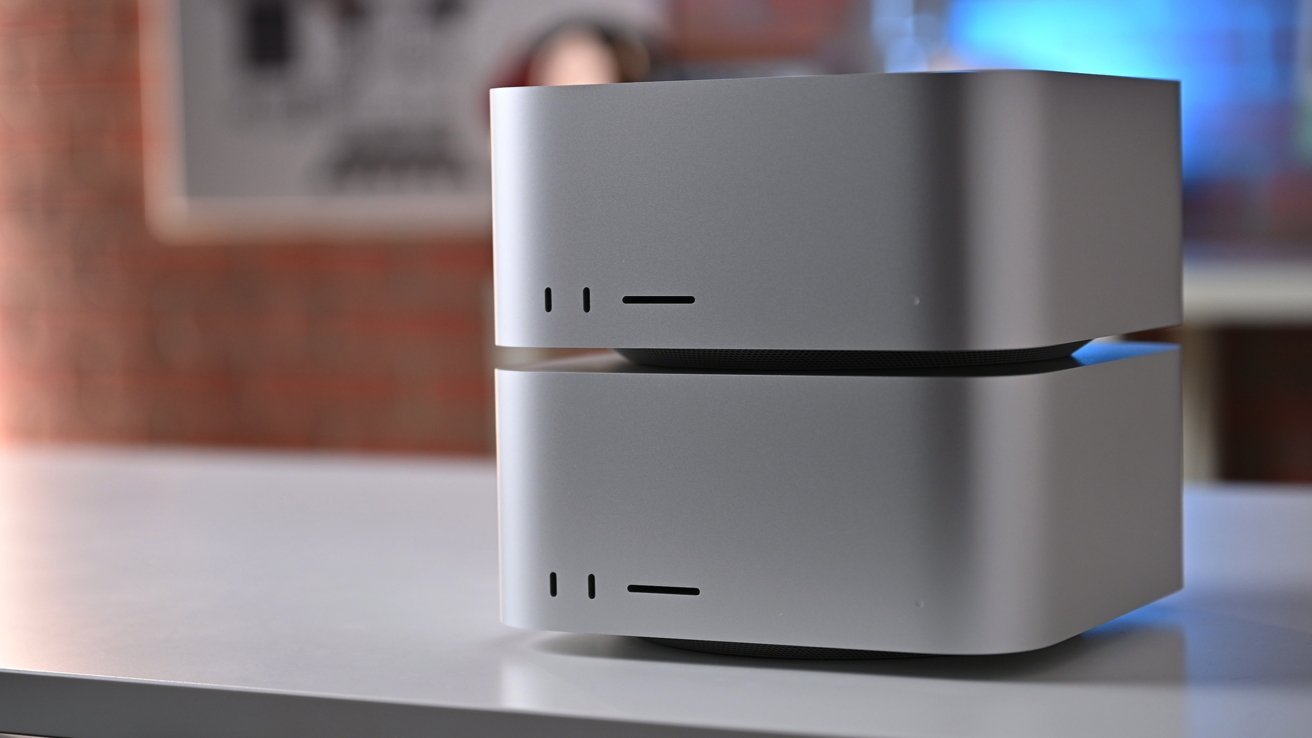
Clusters can be really worth it when using multiple high-spec Macs together
Where a cluster like this comes into play is when you need more performance than you can get from a single powerful Mac. If a model is too big to work on a single Mac, such as constraints on memory, a cluster can offer more total memory for the model to use.
Ziskind offers that, at this stage, a high-end M4 Max Mac with vast amounts of memory is better than a cluster of lower-performance machines. But even so, if your requirements somehow go beyond the highest single Mac configuration, a cluster can help out here.
However, there are still some limitations to consider. While Thunderbolt is fast, Ziskind had to resort to using a Thunderbolt hub to connect the nodes to the host Mac, which reduced the available bandwidth.
Directly connecting the Macs together solved this, but then it runs into problems such as the number of available Thunderbolt ports to connect multiple Macs together. This can make scaling the cluster problematic.
He also ran into thermal oddities, where the host Mac mini was running especially hot, while nodes ran at a more reasonable level.
Ultimately, Ziskind found the Mac mini cluster tower experiment was interesting, but he doesn't intend to use it long-term. However, it's still relatively early days for the technology, and in cases where you use multiple high-end Macs for a sufficiently tough model, it can still work very well.
Read on AppleInsider



